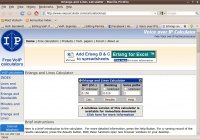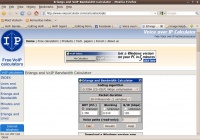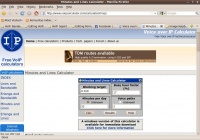VoIP Cookbook: VoIP Capacity Planning
By using Erlangs and Lines Calculator, you can obtain the number of Busy Hour Traffic (BHT) of a number of lines. In our example, we simulate 2, 4 and 8 voice paths facilitated by 64 Kbps connectivity with some Blocking values. The calculation result can be seen at the following table:
| Voice Path | Blocking | BHT (Erlangs) |
|---|---|---|
| 2 | 0.01 | 0.15 |
| 2 | 0.03 | 0.25 |
| 2 | 0.10 | 0.55 |
| 4 | 0.01 | 0.85 |
| 8 | 0.01 | 3.10 |
This calculator can be used to estimate the amount of bandwidth required to deliver the traffic, when the Busy Hour Traffic is known. By using Erlangs and bandwidth calculator, we can obtain the number of Busy Hour Traffic (BHT) of a given Codec. Suppose we run the simulation using a variety of bandwidth values and G.729 Codec; we will obtain the following result:
| Bandwidth (kbps) | Blocking | Voice Path | BHT (Erlangs) |
|---|---|---|---|
| 64 | 0.01 | 2 | 0.15 |
| 64 | 0.03 | 2 | 0.25 |
| 64 | 0.10 | 2 | 0.55 |
| 128 | 0.01 | 5 | 1.35 |
| 256 | 0.01 | 10 | 4.45 |
| 512 | 0.01 | 21 | 12.80 |
The Minutes and Lines Calculator allows us to estimate how many voice channels are needed for a given minutes of calls on the network. A network planner must make sure that the network has sufficient bandwidth to accommodate communication session at peak hours. As shown in the Figure, The Busy Hour Factor parameter is a percentage of daily minutes of calls made during the most busy hour in a given day. The default value 17% is an acceptable percentage for an office operating 8 hours per day. The percentage is normally higher for an office operating in less number of hours, or an office that often places calls in a different time zone.
The following is the result of calculation for a ADSL channel capable of facilitating only two channels:
| Voice Channel | Blocking | Busy Hour Factor | Minutes / Day |
|---|---|---|---|
| 2 | 0.01 | 17% | 52 |
| 2 | 0.03 | 17% | 88 |
| 2 | 0.10 | 17% | 194 |
| 2 | 0.03 | 20% | 45 |
| 2 | 0.03 | 30% | 30 |
| 2 | 0.03 | 40% | 22 |
It appears that the more we tolerate the number of blocked calls, the more minutes per day we will have. However, the more calls take place during peak hours, or when busy hour factor increases, the less number of minutes per day we will have.
References
- http://www.voipcalculator.com
- http://www.voipcalculator.com/calculator/ervp/
- http://www.voipcalculator.com/calculator/eipb/
- http://www.voipcalculator.com/calculator/mivp/


